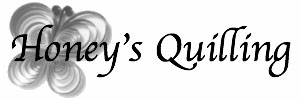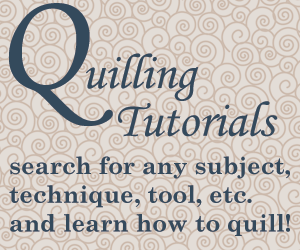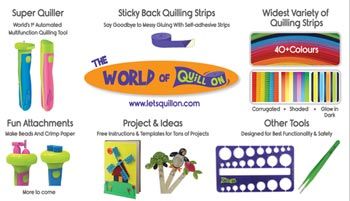Today I am sharing a paper quilling earrings tutorial for a cute pair of earrings that I designed years ago. This was one of my first earring designs that I made. Here I made it in the same natural fall colors as the leaf earring tutorial that I posted a couple weeks ago. Of course you can make them in any fun color combination that you wish! Read on for the step by step photos on how to make these earrings!
This style of making paper quilling earrings with a bunch of little round dots can be expanded to many different shapes! You do have to make sure to seal them very strongly, though, as otherwise they can have a tendency to fall apart more than other earring designs. Tips for sealing these lovely earrings are near the end of the tutorial!
For these earrings, and most of my earrings, I used paper that is 1/8″ (3mm) wide. You can use other widths if you prefer, just adjust the size of the jump rings accordingly! Also, as always, you can make this design in any colors you wish!
Are you new to paper quilling? Check out this Quilling 101 post before you begin!
Materials (for 1 pair of earrings)
- 24 strips of paper, each 3″ long. (I used a dark reddish speck-tacular color by Lake City Craft that has been discontinued, but this brick red by Paplin is quite close).
- 24 strips of paper, each 1 1/2″ long (I used speck-tacular cream color, but any ivory color would work as well)
- 2 strips of paper, approximately 6″ long each (I used the same dark reddish color as above)
- Aluminum handle quilling tool
or another small diameter item like a narrow pen, etc.
- craft glue – I love PPA (at Custom Quilling or on Amazon
)
- sealant and topcoat (optional – to make your earrings sturdy and water resistant. For these I used Ceramcoat sealer
as a base, and 3D Crystal Lacquer
as the shiny topcoat on top)
- earwires
and jump rings
(I use a 5mm diameter jump ring to attach to the earring design and then a 3-4mm jump ring to attach that to the earring hook).
Directions:
- Glue each 3″ strip to a 1 1/2″ strip, so you have two 6″ strips and 24 3 1/2″ strips.
- To make the two big rolls, use a 6″ strips of paper and wrap the end around the end of your aluminum tool (or any other object you are using instead. The diameter of the end of my tool is 3/16″ or 4.5mm). Place a tiny tab of glue at the end of your paper. Hold the end with the dab of glue and make sure it tucks under the strip as you start rolling. Roll the strip of paper around the tool. Once you come to the end of the strip place another dab of glue at the end and glue it tightly. Carefully twist the bead off of the tool without squishing it.
- Use any quilling tool you prefer to roll the 24 small strips into tight circles. I am using this slotted tool
which has an end that is a bit wider than most slotted tools. This gives me a larger center circle in my finished tight rolls. I like the look of this! When you use a slotted quilling tool you get this little straight flap of paper that sticks out into the center of your finished roll. When you do a tight roll you can just use a toothpick or needle tool to push it to the side to make your tight roll have a nice open circle center as you can see here.
- Time to assemble your earrings! Place your open circle on a flat surface (I used a plastic covered cork workboard
). Take one small tight roll and use one dab of glue to stick it to the open circle. For the next several pieces you’ll need to use two dabs of glue – one where it will touch the open circle and one where it will touch the tight circle next to it. You want enough glue for it to stick well, but not so much that it will drip down and create a puddle. Continue adding your tight circles as shown in the photos. You should have one left! (well, 13 left since you need 12 for the other earring 😉
- push the two sides together so they meet and then add the last tight roll on top. Use your fingers, tweezers, or tip of your slotted quilling tool to straighten out the two sides.
- Now it’s time for some sealant! Without any sealant these paper quilling earrings are particularly delicate as they can come apart between any of the little circles. To make them as sturdy as possible I first use a liquid sealer to dip them into. It soaks into the paper and makes it nice and stiff. The one I am currently using and loving is Ceramcoat All Purpose Sealer
(click here to read a review post I wrote with tips and tricks). You can find this sealer at local craft stores in the US. I got mine either at Michael’s or Joanne’s. To use this sealant I pour a little bit into an empty cap, use tweezers to dip the piece in and swish it around, flip it over, until fully coated. Then I dab a paintbrush onto the back so that it pulls out the extra sealant. Dab it on a tissue for a few seconds to get rid of the rest of the excess sealer, and then place onto a plastic surface to dry. I always move it around a couple times while it is drying to make sure it is not sticking to the surface with excess sealant on it.
- After the sealant is totally dry, put the jump rings and ear wires on. Then it is time for the topcoat! A topcoat will give a stronger water resistant coating. For this pair I used 3D Crystal Lacquer
which gave a nice hard and shiny finish. Some other topcoats that I like are Gloss PPA
, matte PPA
(click here to read how to use PPA as a topcoat), and Diamond Glaze
(click here to read my review post). To read all of my posts about different sealants and topcoats, click here.
- So what I did with the3D Crystal Lacquer
was to squeeze it onto the earrings and then use a little brush to spread it around, making sure to get into all of the crevices. Then I hang it up on my earring stand to dry fully.
- All done! Time to make a pair in another color! Here is the size of the earrings:
And a few more photos of these and some of the earlier pairs I made.
Tips for Variations:
- As you can see, some of the pairs that I made earlier differ slightly. For one thing, all of them that I made first have an extra sideways quilled circle at the top to put the jump ring through. This is handy if you only want to use one jump ring instead of two. For this I use a 1 1/2″ strip of paper, make a tight roll, and glue it on sideways. This is not my current preferred way of doing it since you have to put a good glob of glue on it to make sure it is sturdy. (Click here to view some tips on different ways to top your quilled jewelry)
- The other variation is that for some of the pairs the tight circles have an even width of the two colors. For others the middle is thicker with just a thin out line of the second color. The difference is that for the ones that look more even, I start rolling with the shorter color on the inside. For example for the pair in the tutorial there is 3″ of cream and 1 1/2″ of dark red. I start rolling with the dark red end. If I had wanted a thick cream layer in the middle and a thin border of dark red, I would have started rolling from the cream side.
- Of course I’m sure you can come up with many variations of your own! All one color? More than 2 colors? A different shape? Larger? Smaller? See what you can come up with! If you do, I’d love to see! Tag me on instagram, facebook, or twitter. #honeysquilling or @honeysquilling
I hope you enjoyed this tutorial for the teardrop paper quilling earrings, let me know what you think!
- Click here to view more free paper quilling tutorials!
- Click here to view paper quilling tips and tricks!
- Click here to view a list of places to buy quilling supplies around the world!
- Click here to view some of my own quilling projects, with tips so you can make your own if you’d like!
*All products and supplies mentioned in this post I purchased and/or made on my own.
*This post contains some affiliate links, and some non affiliate links. If you purchase products through the affiliate links I get a small percentage (at no extra cost to you!). I only link to products that I believe in and/or love to use myself. Thank you for supporting my blog!







































Cool 🙂
Elegant but with simplicity, thanks Honey!
☺️
Love your blog, can ypu specify if 5 mm is the inner diameter of jump ring?
Hi! I think jump rings are typically measured by the outer diameter